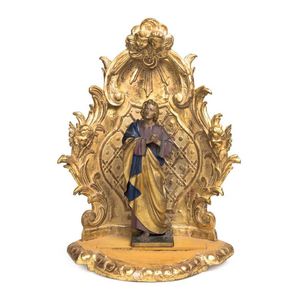Gold-Lacquered Bronze Buddha Figure, Late Ming Dynasty (17th Century)
You must be a subscriber, and be logged in to view price and dealer details.
Subscribe Now to view actual auction price for this item
When you subscribe, you have the option of setting the currency in which to display prices to $Au, $US, $NZ or Stg.
- Ming Dynasty - The Ming Dynasty was a ruling dynasty of China from 1368 to 1644. It succeeded the Yuan Dynasty and preceded the Qing Dynasty. The Ming Dynasty was established by Zhu Yuanzhang, a former Buddhist monk who became a rebel leader and eventually overthrew the Mongol Yuan Dynasty. During the Ming Dynasty, China experienced a period of relative stability and prosperity. The government was centralized and bureaucratic, with the emperor at the top of the hierarchy. The Ming Dynasty is known for its cultural achievements, including the development of porcelain, the invention of movable type printing, and the construction of the Great Wall of China.
- Bronze - An alloy of copper and tin, traditionally in the proportions of about 9 parts of copper to 1 part of tin.
The discovery of bronze in Western Asia in the 4th century enabled people to create metal objects which were superior to those previoulsy possible because of its strength and hardness, and it has been used throughout the world for weapons, coins, tools, statuary and other decorative items.
It is very fluid in a molten state, and its hardness, strength when set, and non-corrosive properties makes it most suitable for casting sculpture.
This item has been included into following indexes:
Visually similar items

A Sino-Tibetan gilt bronze figure of Vajrapani, 11.3 cm high. Provenance: Western Australia Private Collection, acquired in the 1980s from a British estate

A carved and gilt Franciscan style figure of a saint within a carved and gilded mandorla stand decorated with angels, Italian, 19th century, 78 cm high, 52 cm wide, 30 cm deep. Provenance: Property of a Gentleman, Melbourne

A gilded bronze figure of a seated White Tara, Qing dynasty, incised double-vajra mark to the circular recess in the base, 28.5 cm high

A Chinese gilt bronze Buddha, double-vajra mark to the base, 28.7 cm high
